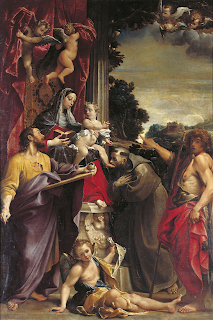Bolognese master produced his most influential work in Rome
 |
| A self-portrait of Annibale Carracci |
The Baroque painter Annibale Carracci was born on this day
in 1560 in Bologna.
Annibale and his followers were to become highly influential
in the development of Roman painting, bringing back the classical tradition of
the High Renaissance.
He was probably apprenticed as a painter with members of his
own family in Bologna. But his talents began to develop during a tour of
northern Italy in the 1580s. He lodged in Venice with the painter Jacopo
Bassano, whose style of painting influenced him for a time.
Annibale has been credited with rediscovering the early 16th
century painter Correggio, who had almost been forgotten outside Parma.
Annibale’s Baptism of Christ, painted in 1585 for the Church of San Gregorio in
Bologna, is a brilliant tribute to him.
In 1582 Annibale opened a studio in Bologna with his
brother, Agostino Carraci, and his older cousin, Ludovico Carracci. While
working there, Annibale painted The Enthroned Madonna with St Matthew in 1588
for the Church of San Prospero in Reggio.
By the time Annibale collaborated with the other two
Carracci on frescoes in the Palazzo Magnani (now the Palazzo Salem) and two
other noble houses in Bologna, he had become the leading master among them.
 |
| Carracci's Madonna Enthroned with St Matthew hangs in a gallery in Dresden |
In 1595 Annibale went to Rome to work for the rich, young
cardinal Odoardo Farnese, who wanted the principal floor of his palace
decorated with frescoes.
In Rome, Annibale studied Michelangelo, Raphael and ancient
Greek and Roman art in order to adapt his style to his new surroundings.
After decorating the study in Palazzo Farnese, he was joined
by his older brother, Agostino, in the chief enterprise of his career, painting
the frescoes of the coved ceiling of the Galleria with love fables from Ovid.
These decorations were considered to be a triumph of
classicism tempered with humanity. The powerfully modelled figures in these
frescoes have been seen as an imaginative response to Michelangelo’s frescoes
on the ceiling of the Sistine Chapel.
The Galleria Farnese became an invaluable place for young
painters to study until well into the 18th century and proved a rich feeding
ground for Gian Lorenzo Bernini among others.
Annibale was underpaid for his long and intense labours in
the Palazzo Farnese and he gave up working on it altogether in 1605.
 |
| Annibale's Baptism of Christ |
He subsequently produced some of his finest religious
paintings, including landscapes for the Palazzo Aldobrandini in Frascati that were to
influence the work of Domenichino and Nicolas Poussin in Rome.
Annibale died at the age of 48 in 1609 in Rome after a few
years of illness. He was buried according to his wish near Raphael in the
Pantheon. Many of his assistants and pupils, such as Domenichino and Guido
Reni, were later to become the pre-eminent artists for the next few decades.
 |
| Part of the ceiling at the Palazzo Fernese in Rome |
Travel tip:
Palazzo Farnese, where Annibale Carracci did some of his
best work in the Galleria, is one of the most important High Renaissance palaces
in Rome. Owned by the Italian republic, the palazzo in Piazza Farnese was given
to the French Government in 1936 for a period of 99 years and currently serves
as the French embassy in Italy. One of the scenes in Puccini’s opera Tosca is
set in Palazzo Farnese.
 |
| Carracci is buried alongside Raphael at The Pantheon in Piazza della Rotonda in the heart of Rome |
Travel tip:
The Pantheon in Piazza della Rotonda, is one of the best
preserved ancient buildings in Rome. It was built as a temple but was converted
into a Christian church in the seventh century. The Pantheon now contains the
tombs of painters and kings. Along with Annibale Carracci, King Umberto I of
Italy, King Victor Emmanuel II of Italy and Raphael are buried there.